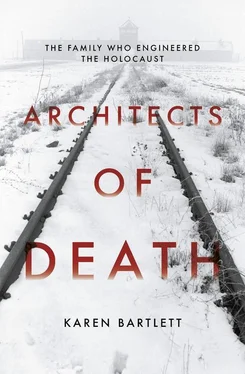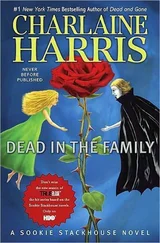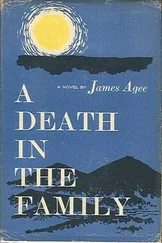Annegret Schüle speculates that a relationship with the SS appealed to Ludwig’s ‘lust for adventure and self-centredness’. Or, as his secretary, Johanne Bushleb, later recalled, his desire to be seen as a ‘man of action’ with a fiery temper and a need to get his own way. [40] Schüle, op. cit., p. 122. AS footnote 212: Sworn statement by Johanna Büschleb, Gudensberg, 1/4/1946, ThHStAW, Collection Jean-Claude Pressac no. 81, sheets 83–90. This quote has been taken from sheet 87.
Certainly Ludwig was operating in an area that he had already claimed as his own – cremation – and he was finally able to step out of his brother’s shadow.
In the immediate aftermath of the war, Ludwig explained to the works council how Topf and Sons had formed a relationship with the SS. Setting the scene, Ludwig explains that Kurt Prüfer was in the process of repairing the Weimar civil crematorium when the dysentery epidemic broke out at Buchenwald, and the death toll began to rise.
‘The epidemic naturally posed a problem for the transportation of the dead bodies, and it was decided to set up a crematorium oven right there on the site, which was totally the right thing to do from a hygiene perspective.’ Ludwig then wrongly describes the administrative origin of the contract, before concluding ‘and then other orders for ovens for Buchenwald and also for the other camps followed’. [41] Schüle, op. cit., pp. 122–3. Ludwig Topf’s post-war explanation concerning the epidemic at Buchenwald. AS footnote 213: Kurt Prüfer personnel file, ThHStAW, J A Topf & Söhne Erfurt no. 14, sheet 119. AS footnote 214: Minutes of Works Council meeting, 27 April 1945, ThHStAW, Collection Jean-Claude Pressac no. 32, sheet 230.
Schüle notes that in this meeting, Ludwig was ‘at pains to conceal the true nature of the concentration camps,’ [42] Ibid.
but he needn’t have bothered, as the works council was already fully aware of camp conditions. The minutes from the meeting note: ‘This background was quite clear to the men of the works council and they were of the opinion that it was not something they needed to be concerned about.’ [43] Ibid.
Despite describing the origin of Topf and Sons’ relationship with Buchenwald as a public service, undertaken for health and safety purposes, the level of complicity between the company and the SS could not be denied. From 1940 onwards, Topf and Sons supplied the camp with the urns, urn lids, urn stamps and firebricks used in civil cremation (although they understood that these stamps and firebricks were a lie and a sham).
Still keen to conceal the true nature of life and death in the concentration camps, the SS ordered thousands of urns, stamps and firebricks to maintain the illusion that they were following the strictures of the 1934 Cremation Act which stipulated that ‘the ashes of every corpse must be kept in an officially sealed container and laid to rest in an urn grove, urn plot or a grave’. As Topf and Sons were well aware, identifying individual ashes was impossible when multiple bodies were incinerated at one time in double-muffle ovens. Maintaining the façade, however, prisoners from Buchenwald, Dachau and Auschwitz would later describe how they assisted the SS in scooping up random dirt and ash, before shovelling it into individual capsules which could then be sealed, tagged and sent – for a fee – to the families of victims. (This ‘service’ was never offered to Jewish families.) Lilly Kopecky, a Slovak Jewish prisoner at Auschwitz explained: ‘When German non-Jews died, their families were sent notice of their deaths along with a letter giving them the opportunity to purchase an urn containing the ashes of their loved ones.’ Lilly’s job was to accompany an SS officer, once a week, into the Auschwitz crematorium where she would then ‘sweep up all the dirt I could find and dump it into the urns’. The SS officer would then seal each urn, before Lilly completed the process. ‘I had a set of stamps on my desk with which I put three lines on the urn lids, one for date of birth and one for date of death.’ [44] Schüle, op. cit., p. 124. Lilly Kopecky quotes about urns. AS footnote 218: Lore Shelly (ed.), Schreiberinnen des Todes, Bielefeld, 1992 (first published as Secretaries of Death, Shengold, 1986), p. 255.
In 1997, a renovation of the attics at Buchenwald revealed hundreds of ash capsules, some empty and some filled – but all supplied by Topf and Sons.
The outbreak of war saw an influx of new prisoners to Buchenwald – including the arrival of thousands of Soviet prisoners of war between September 1941 and summer 1942. During this time the camp became a killing field, with 8,000 former Soviet soldiers and civilians shot dead in stables that had been made to look like a centre for medical checkups. The prisoners would be led in to a room one by one and instructed to line up against a wooden ruler, which they were told would be used to measure their height. Unbeknownst to them, a member of the SS was standing behind them, concealed in a special cupboard, and would then shoot them in the back of the head through a slit in the ruler.
Once again this mass murder placed an unprecedented strain on the camp’s abilities to dispose of so many bodies, and a double-muffle mobile oven from Topf and Sons was brought back into commission to assist with the gruesome task.
One prisoner, Max Girndt, described how the machine was stuffed with bodies in quick succession ‘one body after another at intervals of just a few minutes. Just as in Nero’s day, the burning was done publicly under a blue sky in bright sunshine for all the prisoners to see.’ [45] Schüle, op. cit., p. 151. AS footnote 2: Report of Max Girndt, 1945, Buchenwald Memorial Archive 32/IX-63.
He added grimly that ‘since it was hot and there wasn’t any wind, the ash of our cremated comrades fell as a shower of fine dust across the whole camp, even into the food bowls and pots in the barracks and the cauldrons in the canteen.’ Girndt said the ‘specialists’ who operated the oven boasted that there were up to 200 such machines operating across Germany and the occupied territories.
To cope with the overload, work began to enlarge the Buchenwald crematoria – with two triple-muffle ovens designed by Kurt Prüfer. Later, Topf and Sons would name them the ‘Auschwitz model’, but they were put into operation at Buchenwald first.
One former prisoner, Hans Neuport, worked on the building of the enlarged crematorium at Buchenwald and vividly recalled the role Topf and Sons played in its creation.
When special orders were issued we had to leave the site for a while. Special orders were issued when newly arrived prisoners were to be liquidated in the crematorium at once… for the most part these pitiable victims were Russian PoWs, officers and civilian… I saw these proceedings with my own eyes from a hiding place… I heard several earth-shattering screams one after another, so I looked through a gap in the wooden boarding and saw a Russian, still in his uniform, tied to one of the sliding shelves used with the crematorium chamber and pushed into the oven while he was still alive. His dying screams were the most horrific thing I ever heard in my life. [46] Schüle, op. cit., pp. 151–2. AS footnote 3: ‘August’ presumably refers to August Brück. AS footnote 4: Report of Hans Neupert, Buchenwald Memorial Archive 31/42. AS footnote 5: Report of Hans Neupert, 24 July 1954, Buchenwald Memorial Archive 50-2-33.
This act was performed by three criminal prisoners employed in the crematorium and witnessed by a 69-year-old oven fitter from Topf and Sons named Martin Holick, who was ‘completely shattered by what he had seen’, according to Neuport. Holick was a fitter in Kurt Prüfer’s department and later spent a year working on site at the concentration camp in Birkenau after building the first of the two three-muffle ovens at Buchenwald. Hans Neuport’s devastating account vividly reconstructs the close working relationships Topf employees struck up with other workers in concentration camps – and how intimately they were involved with the most heinous of crimes.
Читать дальше












